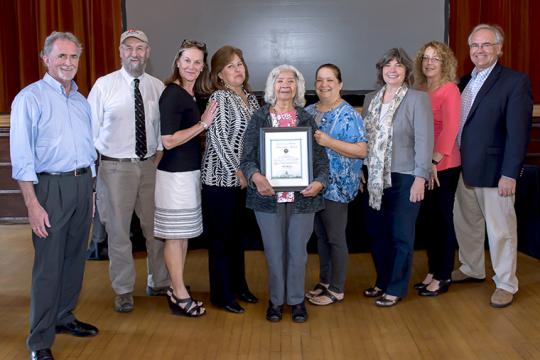Preserving Cultural Heritage
Anthropological Studies Center Receives Governor's Award for Project with Caltrans Kashaya Pomo Tribe and CA State Parks
After receiving an award from the Governor's office, a cultural heritage project involving Sonoma State University, Caltrans, the Kashaya Pomo tribe and California State Parks is being hailed as a model for government agencies in preserving Native American cultural heritage in other states and at the federal level.
The Kashaya Pomo Cultural Landscape Project received the 2016 Governor's Historic Preservation Award. The project involved a multi-year community based study conducted by Caltrans, the Kashaya Pomo tribe, Sonoma State University's Anthropological Studies Center and California State Parks. The project was initiated in 2008 and completed in May 2015.
"This is a new way to think about heritage management," says Sonoma State Anthropology Professor Margaret Purser. "Now there are agencies up to the level of the federal government asking to be allowed to use the material as a model to conduct these kinds of projects."
“Collaborative models like ours are so important because they demonstrate how agencies can serve mandated public needs such as transportation safety and access to public services while protecting the vital cultural heritage needs of tribes," says Katherine Dowdall, Caltrans' principal investigator on the project.
"With tribal living heritage, the focus is on maintaining and restoring tribal landscapes so that they are kept in usable condition for their communities.”
The project documented the Kashaya Pomo tribal cultural landscape as living heritage and identified ways to incorporate Kashaya values and stewardship practices into heritage management practices by state agencies. It included analysis of how the Kashaya landscape is maintained as living heritage at the scale of the community, the family, and the individual. The project includes 40 miles of Kashaya ancestral lands along the coast and interior lands along Highway 1 from Salmon Creek to the Gualala River.
“The land is always saying things to the people — how things are structured over the landscape is part of that language," says Otis Parrish, Kashaya Pomo elder and tribal scholar, and the project's principal investigator for the Kashaya Pomo tribe. "We are taught when we are little how to listen to the land; how to receive from it, and give back to it so that we go in the right way to gather food and medicine; hunt and fish; recite our ancestral prayers, songs, and narratives that are part of our land; and honor our ancestors who lived, prayed, and kept the land healthy before us. Protecting our places in the Kashaya way is our mandate from our elders and their elders before them.”
This insight into the dynamic and culturally specific ways that Kashaya tribal members link and perpetuate their traditional places, narratives, and activities formed the basis for a culturally sustainable heritage management plan for Caltrans, California State Parks and the Kashaya Pomo tribe. As part of this project, a Kashaya heritage driving tour and walking trail will be available to the public in May 2017.
The Center routinely works with state agencies on projects requiring anthropological site surveys and excavations, including several Native American sites. According to Purser, the university is unique in its approach. "Sonoma State pioneered this idea that when you're developing a project in a tribal area, you ask people in that tribe in that area to be part of that planning," she says. This approach was developed in the 1970s by Anthropological Studies Center founder David Fredrickson. National laws requiring this consultation were not written until 1990.
This collaborative work between the Kashaya Pomo tribe and SSU’s Anthropology Department and Anthropological Studies Center has been developing since the 1970s. Dowdall and Parrish are alumni of Sonoma State's Anthropology Department.
The honor was bestowed at a ceremony in Sacramento on Nov. 10. This the only official preservation award presented by the State of California in recognition of outstanding achievements in the field of historic preservation. Reno Keoni Franklin, chair of the Kashaya Pomo tribe, accepted the award on behalf of the project. Marking a growing trend in California’s heritage preservation, three of the 12 total awards given out this year went to Native American collaborative projects.
About the Anthropological Studies Center
The Sonoma State University Anthropological Studies Center has been assisting environmental firms, nonprofit organizations, private property owners, and government agency clients with cultural resources issues since 1974. The Center offers a proven team with the ability to undertake a wide range of complex cultural resources management tasks.
The team is notable for the depth of its experience and training, with 13 salaried and hourly employees with M.A. or higher degrees, and nine registered professional archaeologists with specialties in prehistoric and historical archaeology among the senior staff.
Photo:
Left to right, ASC staffer Michael McGowan; former ASC director Adrian Praetzalis; Caltrans Project Manager and SSU alumna Kathy Dowdall; Kashaya language educator Sandy Pinola; Kashaya language educator Inez Scott Adam (holding award); Kashaya Tribal Council member Marlene Adam; SSU Anthropology Professor Margaret Purser; SSU anthropology alumna Jennifer Ferneau-Darcangelo; and Dean of the School of Social Sciences John Wingard.
Photo Courtesy California State Parks



